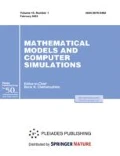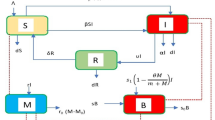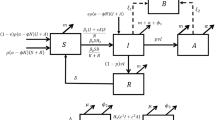Abstract
Awareness programs by the media play a pivotal role in the control of infectious diseases. In this paper, we formulate and analyse a mathematical model for listeriosis incorporating aware individuals. Mathematical analyses of the model are done and equilibrium points determined. The model has three equilibria; namely; the disease-free, the bacteria-free, and the endemic equilibria. Local asymptotic stability of the equilibria is established based on the food contamination threshold \({{\mathcal{R}}_{f}}.\) Numerical simulations are carried out and the effects of various parameters on the model state variables investigated. The results from numerical simulations reveal that an increase in the efficacy of awareness programs, the rate of implementation of awareness programs, and the rate at which unaware susceptible become aware result in the reduction of listeriosis in the human population. The results have important implications in the control and management of listeriosis.






Similar content being viewed by others
REFERENCES
K. Hu, S. Renly, D. Edlund et al., “A modeling framework to accelerate food-borne outbreak investigations,” Food Control 59, 53–58 (2016). https://doi.org/10.1016/j.foodcont.2015.05.017
E. Tambo, C. S. Yah, and G. Madjou, “Deadly Listeriosis outbreaks in South Africa and Australia: Re-inforcing food safety surveillance and emergency response actions,” J. Adv. Virol. Res. 1 (1), 1–9 (2018).
S. Simjee (Ed.), Foodborne Diseases (Humana Press, Totowa, NJ, 2007). https://doi.org/10.1007/978-1-59745-501-5.
F. Allerberger and M. Wagner, “Listeriosis: a resurgent foodborne infection,” Clin. Microbiol. Infect. 16 (1), 16–23 (2010).
WHO, World Health Organization (Accessed 2019-12-16). https://www.who.int/news-room/fact-sheets/detail/listeriosis.
B. Swaminathan and P. Gerner-Smidt, “The epidemiology of human listeriosis,” Microbes Infect. 9 (10), 1236–1243 (2007).
X. Yang, L. Chen, and J. Chen, “Permanence and positive periodic solution for the single-species nonautonomous delay diffusive models,” Comput. Math. Appl. 32 (4), 109–116 (1996).
J. M. Tchuenche, N. Dube, C. P. Bhunu, R. J. Smith, and C. T. Bauch, “The impact of media coverage on the transmission dynamics of human influenza,” BMC Public Health 11 (1), S5 (2011). https://doi.org/10.1186/1471-2458-11-S1-S5
S. Samanta, S. Rana, A. Sharma, A. K. Misra, and J. Chattopadhyay, “Effect of awareness programs by media on the epidemic outbreaks: A mathematical model,” Appl. Math. Comput. 219 (12), 6965–6977 (2013).
Y. Li, and J. Cui, “The effect of constant and pulse vaccination on SIS epidemic models incorporating media coverage,” Commun. Nonlin. Sci. Numer. Simul. 14 (5), 2353–2365 (2009). https://doi.org/10.1016/j.cnsns.2008.06.024
F. Al Basir, S. Ray, and E. Venturino, “Role of media coverage and delay in controlling infectious diseases: A mathematical model,” Appl. Math. Comput. 337, 372–385 (2018).
A. Sharma and A. K. Misra, “Backward bifurcation in a smoking cessation model with media campaigns,” Appl. Math. Modell. 39 (3–4), 1087–1098 (2015).
R. K. Rai, A. K. Misra, and Y. Takeuchi, “Modeling the impact of sanitation and awareness on the spread of infectious diseases,” Math. Biosci. Eng. 16 (2), 667–700 (2019). https://doi.org/10.3934/mbe.2019032
A. K. Misra, R. K. Rai, and Y. Takeuchi, “Modeling the control of infectious diseases: Effects of TV and social media advertisements,” Math. Biosci. Eng. 15 (6), 1315–1343 (2018). https://doi.org/10.3934/mbe.2018061
V. Verma and A. Bhadauria, “Global dynamics of a mathematical model on smoking: Impact of anti-smoking campaign,” J. Math. Model. 7 (1), 49–62 (2019).
D. K. Das, S. Khajanchi, and T. K. Kar, “The impact of the media awareness and optimal strategy on the prevalence of tuberculosis,” Appl. Math. Comput. 366, 124732 (2020).
W. Zhou, Y. Xiao, and J. M. Heffernan, “Optimal media reporting intensity on mitigating spread of an emerging infectious disease,” PloS One 14 (3), e0213898 (2019).
G. O. Agaba, Y. N. Kyrychko, and K. B. Blyuss, “Time-delayed SIS epidemic model with population awareness,” Ecol. Complexity 31, 50–56 (2017). https://doi.org/10.1016/j.ecocom.2017.03.002
G. O. Agaba, Y. N. Kyrychko, and K. B. Blyuss, “Dynamics of vaccination in a time-delayed epidemic model with awareness,” Math. Biosci. 294, 92–99 (2017).
A. K. Misra, A. Sharma, and J. B. Shukla, “Modeling and analysis of effects of awareness programs by media on the spread of infectious diseases,” Math. Comput. Modell. 53 (5–6), 1221–1228 (2011).
M. N. Imbusi, W. Mutuku, and F. Nyabadza, “A mathematical model for Jiggers infestation incorporating effects of media campaigns,” Commun. Math. Biol. Neurosci. 2019, Article ID 25 (2019). https://doi.org/10.28919/cmbn/4096
S. Osman, O. D. Makinde, and D. M. Theuri, “Stability analysis and modelling of Listeriosis dynamics in human and animal populations,” Global J. Pure Appl. Math. 14 (1), 115–137 (2018).
P. J. Witbooi, C. Africa, A. Christoffels, and I. H. I. Ahmed, “A population model for the 2017/18 listeriosis outbreak in South Africa,” PloS One 15 (3), e0229901 (2020).
C. W. Chukwu and F. Nyabadza, “A mathematical model and optimal control for Listeriosis disease from ready-to-eat food products,” Preprint medRxiv (2020). https://www.medrxiv.org/content/10.1101/2020.10.11.20210856v1.
C. W. Chukwu, J. Mushanyu, M. L. Juga, and Fatmawati, “A mathematical model for co-dynamics of Listeriosis and bacterial Meningitis diseases,” Commun. Math. Biol. Neurosci. 2020, Article ID 83 (2020).
Y. Liu and J. Cui, “The impact of media convergence on the dynamics of infectious diseases,” Int. J. Biomath. 1 (1), 65–74 (2008).
N. Kaur, M. Ghosh, and S. S. Bhatia, “Modeling and analysis of an SIRS epidemic model with effect of awareness programs by media,” Int. J. Math. Comput. Nat. Phys. Eng. 8 (1), 233–239 (2014).
C. W. Chukwu and F. Nyabadza, “A theoretical model of listeriosis driven by cross-contamination of ready-to-eat food products,” Int. J. Math. Math. Sci. 2020, Article ID 9 207 403 (2020).
A. K. Misra, A. Sharma and J. B. Shukla, “Modeling and analysis of effects of awareness programs by media on the spread of infectious diseases,” Math. Comput. Model. 53 (5–6), 1221–1228 (2011).
M. J. Keeling and P. Rohani, Modeling Infectious Diseases in Humans and Animals (Princeton Univ. Press, Princeton, NJ, 2008).
P. van den Driessche and J. Watmough, “Reproduction numbers and sub-threshold endemic equilibria for compartmental models of disease transmission,” Math. Biosci. 180 (1–2), 29–48 (2002).
S. M. Blower and H. Dowlatabudi, “Sensitivity and uncertainty analysis of complex models of disease transmission: An HIV model as an example,” Int. Stat. Rev. 62 (2), 229–243 (1994).
ACKNOWLEDGMENTS
The authors would like to thank the Faculty of Science at the University of Johannesburg for their support in the production of this manuscript. The authors are grateful to the anonymous reviewers for their lucrative suggestions and comments.
Funding
No funding received for this research work.
Author information
Authors and Affiliations
Corresponding author
Ethics declarations
COMPETING INTERESTS
The authors declare that they have are no competing interests.
AUTHOR’S CONTRIBUTIONS
CW Chukwu carried out the analytical, and numerical simulations. Both authors formulated and commented on the final version of this work.
Rights and permissions
About this article
Cite this article
Chukwu, C.W., Nyabadza, F. Mathematical Modeling of Listeriosis Incorporating Effects of Awareness Programs. Math Models Comput Simul 13, 723–741 (2021). https://doi.org/10.1134/S2070048221040116
Received:
Revised:
Accepted:
Published:
Issue Date:
DOI: https://doi.org/10.1134/S2070048221040116




